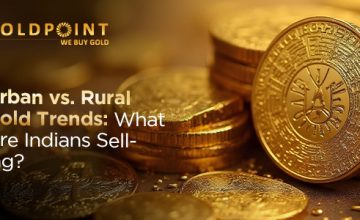
- Jun, 07 2023
- | Sell Gold
Sovereign Gold Bonds vs Physical Gold
If you’re considering investing in gold, consider buying physical gold or opt for sovereign gold bonds. Both options have advantages and disadvantages, so it’s essential to carefully weigh your options before deciding. Physical gold, such as gold bars or coins, can be a tangible asset that you can hold in your possession. It can also serve as a hedge against inflation and economic uncertainty. At the same time, physical gold requires secure storage and insurance, which can be a hassle for some investors. On the other hand, sovereign gold bonds are issued by the government and can be purchased through banks, brokers, and designated post offices. They pay interest in the form of periodic coupons and can be traded on exchanges. One advantage of sovereign gold bonds is that they offer a way to invest in gold without needing physical storage. They are also backed by the government, making them a more convenient and secure investment option for some investors.
| Parameters | Physical Gold | Sovereign Gold Bonds |
| Meaning | Physical gold’s purity may not be less than 99.5%. | These government securities are denominated in gold. |
| Price | Physical gold prices are not constant. | Here the government determines the issue rate. |
| Lock-in period | No lock-in period is there | 5 years lock-in period is there |
| Investment | Gold biscuits or Gold coins are available in the standard denominations of 10 grams. | Gold bonds are issued in units. One unit is equal to 1 gram. The minimum investment is 1 gram of gold, while the maximum limit is 4 kgs of gold/investor. |
| Taxation | The capital gains from a gold investment held for less than 3 years are taxable as per the investor’s income tax slab rates. | The capital gains tax on redemption is zero. However, the capital gains for premature redemption are taxable similar to physical gold. |
| Liquidity | One can easily buy physical gold from any or exchange from any jeweller. | One can trade their bonds on the stock exchange after the 5 year lock-in period |
| Demat Account | Not Required | Not mandatory |
Investing in Sovereign Gold Bonds (SGBs)
Sovereign gold bonds (SGBs) are an attractive option for investors to add to their portfolios. Issued by the government, these bonds offer a way to invest in gold without needing physical storage. The bonds are in denominations of 1 gram, 5 grams, 10 grams, 50 grams, and 100 grams. They can be bought from banks, Stock Holding Corporation of India, and designated post offices., and pay periodic coupons in the form of interest.
One gold sovereign is equivalent to one SGB, making it a convenient unit for investing in these bonds. SGBs can also be traded on exchanges, offering the potential for price appreciation. Additionally, they are backed by the government, making them a potentially more secure investment than physical gold.
Additional Read:Top 10 Reasons to Invest in Gold
Pros of Investing in Sovereign Gold Bonds
1. No need for physical storage: SGBs can be purchased and held electronically, eliminating the need for secure storage and insurance.
2. Interest payments: SGBs pay periodic coupons as interest, providing an additional source of income.
3. Ease of purchase: SGBs can be purchased through banks, brokers, and designated post offices, making them more accessible than physical gold.
4. Liquidity: SGBs can be traded on exchanges, providing the potential for price appreciation and the ability to sell the investment easily.
Cons of Investing in Sovereign Gold Bonds
1. No physical possession: SGBs are held electronically, so investors do not have tangible assets.
2. Potential for default: While the government backs SGBs, there is still a risk of default.
3. Market risk SGBs are subject to market fluctuations and can decline in value.
4. Limited appreciation potential: The appreciation potential of SGBs may be limited compared to physical gold, as they are only paying periodic interest rather than benefiting from the full appreciation of the gold price.
Investing in Physical Gold
Physical gold, such as gold bars or coins, can be a tangible asset that investors can hold. It also provides a hedge against inflation and helps to diversify your portfolio. Additionally, gold has a low correlation to other asset classes, making it a good hedge against market volatility. Investing in physical gold is an excellent option for investors looking to protect their wealth and ensure long-term financial stability. If you are considering investing in physical gold, it is important to be aware of the current gold price. One way to do this is by checking the gold jewellery price today, which can give you a general idea of the market value of gold. However, investing in physical gold comes with its own set of considerations. For example, physical gold requires secure storage and insurance to protect it from theft or damage
Pros of Investing in Physical Gold
1. Tangible asset: Physical gold can be held in one’s possession, providing a sense of ownership and control.
2. Potential for price appreciation Physical gold can appreciate, providing the potential for greater returns compared to SGBs, which only pay periodic interest.
3. Hedge against inflation: Physical gold can potentially maintain its value or even appreciate in times of economic uncertainty or inflation.
4. Diversification: Physical gold can offer diversification benefits for an investment portfolio by reducing the overall risk of the portfolio.
5. No default risk: Physical gold does not carry the risk of default, as any issuer does not back it.
Cons of Investing in Physical Gold
1. Secure storage and insurance: Physical gold requires safe storage and insurance to protect it from theft or damage.
2. Cost and time: The purchase and sale of physical gold can be more time-consuming than other investment options.
3. Market risk: Physical gold is subject to market fluctuations and can decline in value.
4. Limited liquidity: Physical gold may be more difficult to sell quickly than SGBs, which can be traded on exchanges.
Wrapping Up
When it comes to investing in gold, investors have the option of choosing between a sovereign gold bond vs physical gold. A sovereign gold bond allows investors to invest in gold without needing physical storage and is backed by the government. On the other hand, physical gold is a tangible asset that can be held in one’s possession. It’s essential for investors to carefully consider the pros and cons of each option before making a decision. When deciding between a sovereign gold bond and physical gold, you should consider the current cash for gold and gold jewellery prices and your financial situation and investment goals.










